INTRODUCTION
Our initial steps into competition shooting centered on pistol disciplines because they are popular. But one of the most accessible disciplines that we can talk about for a beginner is anything involving a shotgun. And the popularity of shotgun shooting is only growing!
THE JOURNEY INTO COMPETETIVE SHOOTING
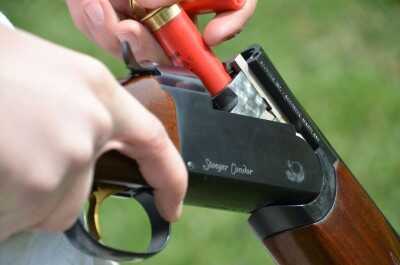
Ep. 1 Getting Started
Ep. 2 Steel Challenge
Ep. 3 USPSA Pistol
Ep. 4 Shotgun
Ep. 5 3 Gun
Ep. 6 High-Power Rifle
Ep. 7 Cowboy Action
Ep. 8 Shotgun II
Ep. 9 IDPA
Ep. 10 Bulls Eye Pistol
Ep. 11 Smallbore Rifle
FUN WITH A SCATTERGUN
Shotguns are used in a wide range of events; from trap, skeet and sporting clays to Scholastic Clay Target Program, to tactical and practical shotgun matches, there are competitions all over the country. For beginners, shotgun is one of the most prevalent disciplines and finding a league night or a range that allows new shooters to participate without a lot of extra steps in the process is relatively straight forward. This makes shotgun shooting one of the simplest disciplines to walk into.
This article will center around beginning to shoot a shotgun from an absolute beginner’s perspective. We’ll focus on the basic aspects of the gun and stance, and give you a few suggestions of where to find events and what the events consist of. We’ll talk a little about shotgun fit as well because it is an important part of enjoying the experience.
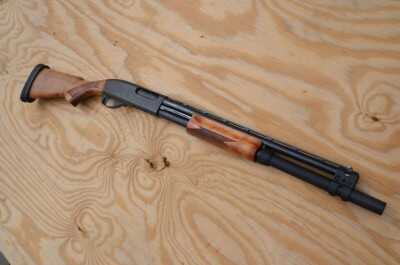
The shotgun that my three boys all started shooting 3 gun and clays with. A Remington 870 in 20 gauge with a shortened stock and an extension and barrel clamp. No costly investment required!
For a new shooter, shotguns should be embraced. Not just because you have many projectiles heading toward your target, and they’re fun to shoot, but because it’s gratifying to knock over steel and turn clays into dust! It’s instant visual confirmation of a hit on target – “bam!” and targets are down or gone. Shotguns are often shunned for their kick or recoil and the power they can pack, but that doesn’t have to be! It’s why there are niche companies, like Parazzi and Krieghoff, that build guns so fine, so tailor-made that they are heirlooms. But since most people cannot afford an heirloom shotgun, we’re going to look at fitting a shotgun in a much more reasonable way. For me, that starts with a Dremel tool and a hacksaw. And no, not for gunsmithing, but simply to cut the stock down, and add a softer recoil pad. It also calls for some sandpaper or a belt sander, or simpler yet, a good shop where I can send my gun. But I don’t even have to go that far – I can buy a youth stock, if I am buying a shotgun, or I can borrow a smaller gun to introduce a new shooter.
And this is where we are going to start our discussion on shotgun shooting – making sure we use one that’s appropriate. I’m not telling you to go buy something new, but before you take your child, wife, or girlfriend out to shoot a scattergun, at least try to see if you can find a semi-auto that runs lighter loads, or borrow one that has a shorter length of pull. Call your buddy who has lopped off the butt of his wooden stock. If you’re a 6 foot 3″ burly male reading this, you still want to digest the parts about fit and your eyes, so don’t run off just yet.
SHORT STOCK
A semi auto usually kicks less because it’s absorbing some of the recoil. You will want to begin with a shotgun that a new shooter can physically handle. Don’t assume you need a 20 gauge, because the mass of the gun being smaller means they sometimes kick as much as a 12 gauge, and some people say it feels harsher than a 12 gauge.
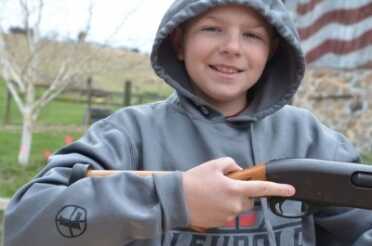
A rough gauge of the length of pull on a stock is to tuck it in your elbox, and see where your trigger finger lines up with the trigger.
So fitting a gun – is it like pants? Do we measure along a particular line of our body? Well, we start with length of pull, and we go from there. The first thing we do to look at length of pull is to measure the distance from the stock in our elbow to where our trigger finger sits. We would like to see, as a rough measurement, that when the butt is in the crook of our elbow, the trigger can be reached by our trigger finger.
A shorter stock brings the weight, the heavy part of the gun, closer to you. This makes the gun easier to manage and swing, for flying targets, and it brings the weight closer to your core, and will enable you to have a more appropriate stance.
As a woman and having three sons who compete, I can tell you from experience that everyone isn’t going to want or need the same things. I don’t have a cheek-piece, I like my stock stippled, my eldest likes a thicker cheek piece, etc. Notice in the photo below that our three guns do not have the same exact cheek pad or stippling pattern, because we all like something a little different and we all handle the guns differently.
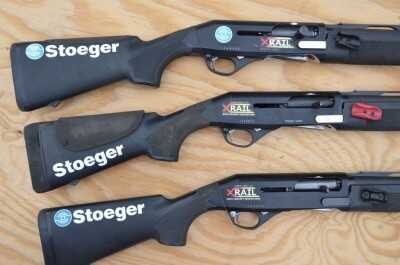
Three identical model shotguns, set up for three different shooters. notice the different stippling patters on the stocks, as well as the foam cheek pads, or lack thereof.
Since you’re going to need a gun, that’s why we covered fit, and as a frugal parent, I’d like to see you borrow a gun or find one that you can use to test out whether you want to shoot shotgun events. If you are going to buy a shotgun, I would look at the affordable companies, as well as GunsAmerica’s online retail website, where you can find some awesome deals!
Larry Potterfield from Midway USA gives an easy-to-understand explanation and some good tips on shotgun fit. I like his straw idea because it addresses that you need to be using the rib on your shotgun and looking at it in a specific way – not from above, or below, but as if it was sighting down it, through a tube.
There are other videos on shotgun fit, this one has some good points on fit relating to where your hands and face should be when mounting the gun, as well as some info on misdiagnosed eye dominance due to poor shotgun fit.
Dry firing – before we even begin to shoot a shotgun, we can dry fire. This is the same as what we did with pistol shooting – we check that the gun is clear, ***no ammo anywhere nearby*** and we work on form and handling. We can dry fire to understand how the trigger feels, to practice mounting the gun, to build our muscle memory and strength, because honestly, shotguns are heavier than pistols, and we’ll get tired fast if we don’t develop some guns for our guns.
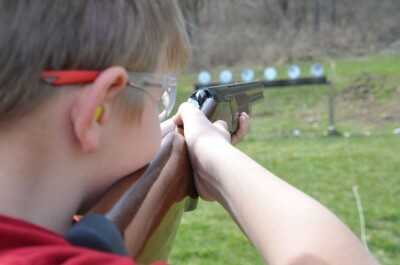
One key in shooting a shotgun well is having a gun that fits. This is a good example of how the eye functions as a rear sight, and being able to see straight down the rib
When I work on dry fire drills with my shotgun, they are either mounting, transitioning, or loading drills. Shotgun dummy rounds are necessary for loading drills, and we can buy them from Brownell’s, and other places, but I prefer the feel and proportions of the ones Brownell’s carry unless I’m working on hand strength, then I want heavy aluminum ones. I practice loading for 3 Gun, but for a new shooter, shotguns can be confusing with all the parts to a shotgun – shell release, bolt, tube, putting a shell on the lifter versus a round in the chamber. It sounds stupidly simple, but for a new shooter, it’s not simple. They will benefit from dry fire drills and the basics of loading the gun without ammo. If you spend just 15 minutes working with dummy rounds, everyone will have a much simpler time on the range, as well as understand more about how the gun works. They will be less nervous and you will all be safer.
SHOTGUN STATIC BASICS
We will start with stance and understanding how we hold a shotgun. For new shooters, getting accustomed to the balance and weight of the gun, and maintaining a stance that will help them counter the recoil is important. They also need to know about mounting the gun and positioning their cheek or face on the gun.
Shotgun shooting requires that you stand solid and have a firm base of support. That can mean a wider stance for your feet, depending on the shooter and their body and skill level. A new shooter will be more comfortable taking a very aggressive stance that has one leg back and weight forward over the balls of their feet. Hinging forward slightly at the hips will also help counter recoil, as will keeping the core muscles tight – like you’re preparing to do a sit-up. For inertia guns, like a Stoeger or Benelli, this can come into play more, since a snappy recoil and muzzle rise from the action of the gun are going to require more active effort on the part of the shooter. Shotguns are not like rifles where we find our natural point of aim and relax to shoot after we’ve set up a solid position based on bone structure. Shotgun requires us to constantly use biofeedback and consciously work to bring the gun back on target. We also want to have an “index” or sort of a very broad natural point of aim that is centered on our target array. Shooting at stationary targets, we need to transition our gun from one target to the next very quickly, and in doing that, we need to keep our face firmly on the gun, our stance solid, and yet remain mobile enough to drive the gun to the next target. So if I was to give a new shotgun shooter a task, I would set up some stationary steel and tell them to shoot a single shot at a time, and think about keeping their core tight and weight forward, shoulder and face firmly into gun, and bringing the front sight back to the next target. I would work on their comfort and control of the gun, then branch out into things like flying clays or the swing of a shotgun. A great drill would be a plate rack, or several pieces of steel (you could even use hunks of 2×4) and have them slowly shoot each one with a good position and form, and then work toward shooting them each with a nice transition from shot to shot and target to target. Once they are comfortable with that skill, I would go find a clay thrower and give them some basics on shooting aerial targets.
AERIAL CLAY BASICS
Targets that are moving are a whole different animal than stationary targets. We need to understand chokes, and pattern, swing and follow through. But for holding and using the shotgun, we want to understand that moving the gun through the arc or swing is going to require a position that is open and allows us to arc across the direction the target is coming from and moving toward. We still need functional tension in our core, but we need to stand with more of an “index” off the direction we want to shoot in, versus being very stationary. So we might for example, set up our body to be facing the place we want to break our shot, the best presentation of the clay, but we will twist a little toward the incoming path of clay so we can swing with it as it crosses into our vision. A good example of setting up your stance for where you want to break the shot is in this video from the Gould brothers.
If we want to break down shooting aerial clays, we can look at 3 distinct ways that shooter Ryan Muller shared in a conversation recently. His main tip is to focus on the clay and shoot where it’s going to be, not where it’s at. You can do this by using the following methods:

Ryan Muller, from Team Stoeger, outlines 3 basic methods for shooting flying clays.
1. Pull through – start from behind the clay, get to it and pull through and fire at the time you get to clay, and maintain the movement as you fire and after. I would call this moving with the clay, in my own language. This is what bird hunters generally do.
2 Pull away – start at the clay, and pull away in front of it as you’re shooting. Following through while maintaining motion.
3. Maintain lead – maintain a constant lead in front of the bird. This means that I have a space or a lead in front of the flaying clay and I maintain it and keep swinging my gun as I break the shot. I would tend to use this on further clays or faster moving clays, especially once I’ve established how fast the birds are moving and where I need to hold.
In all three of these methods, we maintain our swing, or the movement of the gun. We don’t ambush or get to the point we want to shoot and stop the gun, the gun must stay in motion. Often flying clays give the illusion that they are going in one direction, but might also be rising or falling away. So watching the clays and their path is a part of understanding how to shoot aerial clays. Once you understand WHERE they are moving, you can set up to have a the best swing of your shotgun across the path that the clay will travel.
Ryan’s other tip is that you should consider your gun an extension of your pointer finger. Shooting what you see, what you’re pointing at. Shotguns are not rifles, and usually shotguns do not have traditional sights. Shotguns are meant to be pointed and that is how we aim with them. (This excludes shooting slugs and using sights or your rib to aim, which we will cover in the next article on shotguns.)
Flying clays – Some of the finer points.
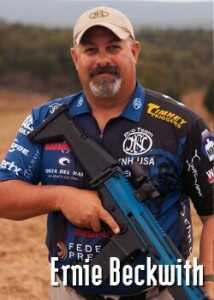
Ernie Beckwith, member of FN Pro Team, shares his tips on shooting Sporting Clays.
I’m not gonna lie, I find sporting clays and fast aerials difficult, but after talking with Ernie Beckwith, FN Pro Team member, I’m anxious to get out with my shotgun and shoot some clays. Ernie competes in sporting clays and shotgun events for Team FN, and has obviously put in some time learning the game.
Ernie concurs with Patrick Kelley on shotgun fit. Fit is critical. Your head and eyes are your rear sight, if they don’t align with the rib of the gun, you are in trouble. “Your eye HAS to be in line with the barrel because where you look is where your shot is going to go,” says Ernie. So if you are too high and looking over the rib, or too low, you will not have a properly aligned “rear sight.”
Shotgun shooting for aerial targets is a “target focused” style of shooting, as opposed to types of shooting that are sight focused. If you come from rifle, USPSA or another discipline that is all about your sight picture, you’re going to have to switch gears for aerials. It’s a whole different ball game!
One could argue that aerial clays shooting is the truest form of instinctive shooting and you’re not going to be good at it until you do it at a subconscious level. You’ll slow down with conscious thought, when you slow down, you’re stopping what comes naturally, and you will hit behind the bird. While we learn through conscious effort (we have to think about something in order to do it), we also need to do a task enough that we don’t have to think about it anymore. One analogy is a puzzle – we have to consciously think about all the parts to the puzzle at first, but once we know what we’re looking for (that odd shade of green or a specific pattern) we don’t need to tell ourselves what we want, we can just find it because we recognize what we want from experience. Shotgun shooting is a lot like a puzzle in that regard. We have to figure out the what and where and how, but once we have a mental and physiological database of the things that we want to see and feel, then we can shoot subconsciously. A great example would be young kids who pick up a gun for 1st time without a sight-focused background – they often are the one who automatically look at bird and shoot because they haven’t been taught otherwise. It’s intuitive for them. They don’t overthink it.
Ernie also talked about the importance of movement of the gun. When we shoot USPSA, 3 Gun, etc. we index targets. This is something like a rough natural point of aim – not as exact as we need for long range rifle shooting, but we at least need to orient off the center of the array or set up so we are not fighting the forces of our own body when shooting at our most difficult target. In shotgun, everything works back from a break point. We want to break the bird at the clearest shot, or where it shows the most face (orange side of bird).
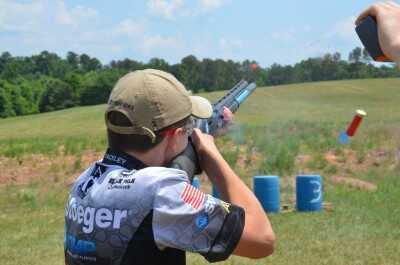
Team Stoeger shooter, Sean Yackley, breaking clays thrown into the air by steel targets that are activated with a shotgun. This is a great example of clays showing you their “face” and how effectively birdshot breaks them.
We only need 1-2 pellets to break it on the face, the edges or sides are a different story. From the break point, we pick a hold point, a point from where it goes from a blur to where it slows down, we want to break the bird with the minimum amount gun movement, smooth and swinging through the shot. To do this well, we want to pay attention to our foot placement. You want to adjust your feet so you can freely unwind through the break point. You do this by pointing one foot beyond the break point so you can swing through it, and the other is indexed toward the look point (where the bird originates in our field of view). Then you’re set up to uncoil like a spring. Setting our feet up correctly will keep our body from binding. And our index or natural point of aim is “through” the break point. This will help us avoid chasing bird and being behind.
We’ll get into more of the finer details on flying birds in our next installment on shotgun, but this should give you some basics to begin. It’s a lot to digest, I know. I keep re-reading this section and wishing I’d have read it before I began shooting clays, because it’s great advice!
WHERE TO SHOOT
Just like our other articles in this series covered where you can shoot, we want to touch on competitions that you can be part of. For the newest of new shotgun shooters, starting with your friend, parent, grandpa, etc. at the range is where you want to begin. With good form and at your own pace.
Once you have the basics mastered, you can begin to check out competitions. A place younger shooters can start is the scholastic Clay target program or a highschool trap and skeet team. Trap shooting is one of the fastest-growing highschool sports. Their level of organization from the scholastic programs is amazing and a great place to begin for young shooters. Fellow competitive shooter Sky Killian has a teenage daughter who participates in her high school trap team. Madison competes with her Fabarms shotgun in trap events, and in 3 Gun with a different shotgun. Madison’s training with one complements competing with the other, and gives her an opportunity to be part of a team sport.
Other places to begin are local sporting clays, trap, and skeet events. I gave links at the beginning of this article and they will take you to web pages where you can search your local clubs for events. In our rural area, I know of at least two clubs where I can show up and shoot clays on a weekday evening.
Wrapping it up and putting it together.
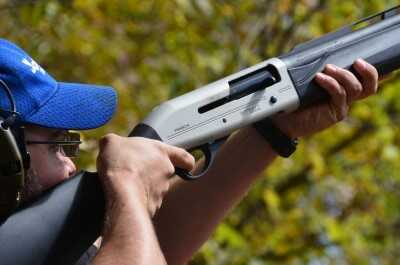
Logan Clark, of Clark Custom Guns, shooting a Franchi Affinity at the 2015 Trijicon World Shooting Championship on a sporting clays course at Rockcastle Shooting Center.
All of these methods and skills are not necessarily THE way to shoot, but ONE way to shoot. Every person does not have the same size, muscle mass, balance, and build. A lanky teenager might need an adjustable comb on their shotgun because their neck is so long, whereas a small youth might have the exact opposite issue. They will have different holds and positions as a result. I like to think about that scenario as something along the lines of what’s discussed in the book “Blink,” by Malcolm Gladwell – that aside from the obvious and measurable things we are taking in consciously, there are some un-measurables in life that experience gives us an eye for, a feel for, and the capacity to pick up on, even if we can’t explain them. It hints to what Ernie said about shotgun shooting at aerials being very instinctive.
The tagline for Franchi shotguns is “Feels right.” I think it’s a great line for a shotgun because sometimes you can’t say why something works for you, you can just say that it feels right. And in shotgun shooting, while we have some suggested methods, we sometimes see the outlier to the norm who has different stance or hold, and they might just do it because it’s what feels right to them – and there’s nothing wrong with that.
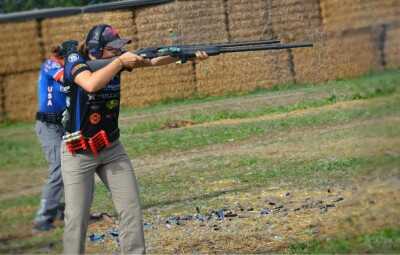
Lena Miculek is a two-time IPSC Shotgun Lady’s World Champion. Her understanding of what it takes to run a shotgun fast allows her to adapt the mechanics of the process to fit her needs.
My best example of this would be Lena Miculek. Her shotgun stance when she shoots static targets is different. I think about it like it’s ballet, almost a plie stance. But as two-time world champion in IPSC shotgun, she’s definitely mastered the dance of shotgun shooting.
And that’s where I’d like to end this first look at shotgun shooting – it’s about doing things safely, comfortably, and if you’re a little different because it feels right for you, go ahead and try it for a bit, ask for input from experienced shooters, and enjoy what you are doing. As you improve your shooting skills, things that initially seemed uncomfortable or impossible might seem reasonable. And for those instructing new shooters, remember that what’s second nature to you might still be so foreign it’s nearly impossible for the student. You might be at the unconscious and second nature side of things Ernie talked about, so be careful not to turn new shooters off by requiring they do it just like you say. Give them room to grow, be flexible, and go have fun!
Additional video you might want to watch: Here’s a video of Lena and Kay Miculek that nicely lays out stance for women and smaller framed shooters.
** If you’re having any trouble viewing the videos we’ve linked to, try to right click and open in new tab. Or you can copy and past the URL:
Midway video on fit: www.youtube.com/watch?v=7hsKCO8Mcfk
Second video on fit: https://www.youtube.com/watch?v=vteCAoPwn-s
Miculek video on stance: https://www.youtube.com/watch?v=TBG1HlUNQs8
About the author: Becky Yackley has been shooting competitively since she began as a teenager with service rifle and smallbore. She’s lived near the typical Marine Corps bases and spent 10 years near DC while her husband was active duty, but has settled into Wisconsin and shooting 3 Gun, USPSA, and Bianchi pistol with her three boys and husband. An avid runner and outdoorswoman, she shoots guns and photos, and sometimes her mouth…which her friends often remind her keeps them “alert” at late hours on road trips. Never known for being quiet, she’s bringing her brand of humor our way this year in hopes of sharing her love for shooting sports with our readers.

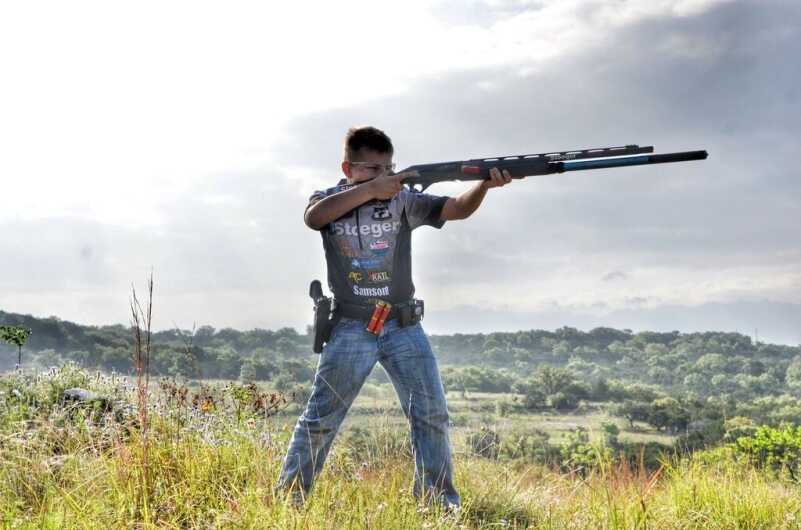
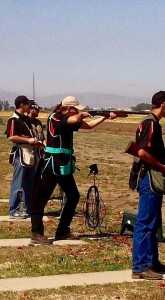
Becky, Thank you for taking the time to do this series on competitive shooting! I am just getting started and this has so much great info
Thanks Pierce! I learned a lot from Ernie with this one…some of it will be in the second part on shotgun.
Another great article… and that picture at the top is killer!
Looks like one of hundreds of pastures in central Kansas.